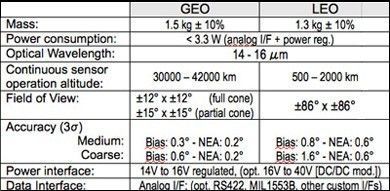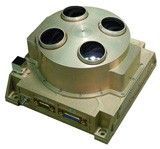
-
StatusCompleted
-
Status date2014-02-27
-
Activity Code4C.010
The objective of this contract has been the definition of the requirements and the design of a Low Cost Coarse Earth Sensor, suitable for use both in GEO telecoms (either as a stand-alone sensor or as a “safe mode” temporary back-up for more accurate attitude sensors like star trackers) and for LEO missions of Earth Observation and constellations (as a reference unit, with low accuracy).
An Engineering Model for GEO applications has been manufactured, assembled and tested.
The design activity has been oriented to the development of a configurable sensor, suitable for GEO/LEO missions, named IRES-C (InfraRed Earth Sensor “Coarse”).
For each IRES-C configuration (depending on GEO/LEO type of mission ) a set of design goals has been identified, aiming to cover an extended number of possible customer requirements:
- Accuracy: Coarse or Medium, employing IR detectors, respectively, with two or three pixels;
- Electrical Configuration: Analog or Digital;
- Data I/F: in case of digital unit, a set of possible I/F is available (RS422, MIL-1553 B, other custom I/Fs);
- Power Section: Power Regulator or DC/DC module.
The sensor design activities have also been driven by the need to obtain a unit with low recurring costs and not using ITAR parts.
A IRES-C EM sensor unit (in the GEO – Coarse, Analog I/F configuration) has been finally manufactured, assembled and tested (functional, performance and environmental tests) in the frame of this contract, employing IR custom detectors (EM quality level) defined, procured and fully characterized with a dedicated test campaign in the frame of the same contract. Finally, suitable test set-ups have been defined and implemented, covering test activities both at IRES-C sensor level and IR detector level.
IRES-C GEO Configuration
The IRES-C development is based on concepts investigated during a previous ESTEC Contract (Ref. 1955/05/NL/JA). The IRES-C development exploits the experience gained by SELEX Galileo in the frame of the GEO spacecrafts’ Earth Sensors family called IRES (IRES-NE and IRES-N2 are the most recent versions of a product born in the 70’ies). The IRES-N2 sensors are still under production, after hundreds of units produced up to now for several TLC programmes worldwide and for Navigation satellites (Galileo constellation).
The IRES-C sensor main characteristics are:

The key objectives of the IRES-C project are summarized as follows:
- Market Segment Opportunities
Obtain a configurable sensor, able to cover either the requirements of GEO missions (as back unit, with low accuracy) or LEO missions (as reference unit with low accuracy), changing only few parts of the assembly.
- Cost
Obtain low recurring cost by design, acting on the basic concepts of work, mechanics, electronics. Optimize manufacturing processes. Simplify on ground acceptance testing.
- Performance
Reduced performance characteristics. Reduced weight and envelope.
- Exportability
Avoid USA key components with ITAR restriction.
The Coarse Earth Sensor potential application missions are those requiring Earth pointing, possibly with stringent constraints on the availability figure and therefore considering the potential use of the IRES-C for Satellite SAFE and/or Earth acquisition control modes; or missions with relaxed Earth pointing requirements but higher cost restrictions.
The IRES-C is an equipment oriented to complete the SELEX Galileo Earth Sensor products’ basket, complementing the IRES-N2 sensor family, which already covers the high range of Earth Sensor requirements in GEO, and extending to the LEO mission requirements (for which SELEX Galileo currently has no products in its catalogue).
The IRES-C is an Earth sensor that observes the Earth within the wavelength band 14÷16μm in order to calculate the Earth angular position in its Field of View (FOV), in terms of Pitch/Roll coordinates.
The Analog configuration outputs raw data (analog signals) that a Logic Unit (implemented at AOCS level) shall properly manage in order to derive the corresponding Pitch/Roll measurements. The relevant AOCS Processing Logic has been already defined and verified (as basic concepts) during the test campaign of the EM unit.
The Digital configuration, which instead implements the Processing Logic inside the IRES-C sensor unit, constitutes a fully autonomous Earth Sensor, with Pitch/Roll measurements readily available as IRES-C outputs.
In order to increase its flexibility, the IRES-C has been developed following a “modular architecture”, with different possible features, depending on the application and on the requested performance.
The modularity has been realized by developing different “optical heads”, which shall be selected at the time of the IRES-C integration in order to customize the unit for GEO or LEO missions. Thus the optical head is the only part that changes, while the same IR detectors and detector assembly, the same mechanical housing and the basic concepts of functioning are maintained both in the GEO and the LEO configurations.
The system architecture is divided into the following main blocks:
- IR Detection
- Scanning mechanism
- Electronic package
In case of analog configuration the Electronic package consists basically of a Mainboard, composed of three sections: Power Supply, Analog Channels, Timing Generator.
In case of digital configuration the Electronic package consists basically of a Mainboard (composed of two sections: Power Supply, Analog Channels) and a Logic section to manage the Pitch/Roll estimation.
The mechanical hardware consists of the optical head and the relevant processing electronics, both contained in the same main housing (coated by Alodyne).
The project is divided into two phases: Phase 1 and Phase 2
Phase 1:
- Requirement review
- Preliminary design
- PDR
- Detailed design
- CDR
Phase 2:
- EM Manufacture
- TRR
- EM Test
- TRB
- Final Review
Objective of Phase 1 is to define the requirements and analyze the architecture of a low cost, low accuracy Earth Sensor meeting the constraints given by two different types of missions: LEO and GEO.
Objective of Phase 2 is the manufacturing and verification by test of an EM Engineering Model of a low cost, coarse Earth suitable for use in GEO TLC as stand-alone or as temporary back-up for more accurate attitude sensors (like star trackers).
In parallel a characterization of the IR detectors has been carried out.
The key scheduled milestones have been completed:
- Negotiation Meeting: September 30th 2008
- PDR: May 19th 2009
- CDR: October 14th 2009
- Phase 2 Formal Authorisation by ESA: December 16th 2009
- TRR: October 15th 2010
- TRB: July 05th 2011
The contract was concluded in mid November 2011.
Completed.
An IRES-C EM unit, GEO-Coarse analog configuration has been manufactured, assembled and tested (functional, performance and environmental tests).
The test campaign has been addressed to verify the main IRES-C performances and to check its response to thermal and mechanical stresses. The EM unit has been tested (in principle) to validate the suitability and the basic concepts of the sensor architecture.
Mechanical stresses (vibrations and shock) at the qualification levels have been applied at the end of the test campaign, mainly to verify the suitability of the mechanical architecture. The electrical parameters measured at each step of the test campaign confirm the integrity of the EM unit.
The results coming from the IRES-C EM test campaign confirm a good behaviour of the IRES-C EM sensor. The unit characterization and performance indicate the validity of the design basic concepts.
The environmental tests applied to the sensor confirm the suitability of the design architecture for Space applications, and in particular for Multimedia platforms.
A dedicated IR detector has been developed for the IRES-C EM unit, in the Coarse configuration, and tested to evaluate the device performance when subjected to mechanical and thermal stresses typical of a Multimedia mission. The results coming from the test campaign confirm the good behaviour of the devices, verifying the validity of the detector design and performance.
The electrical parameters measured at each step of test confirm the integrity of the IR detector even after higher level of mechanical stress. Therefore the environmental tests applied to the devices confirm the suitability of the detector for the IRES-C application.



